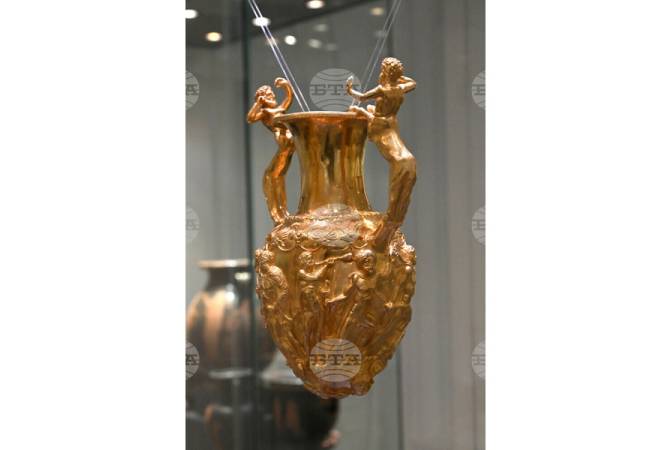BTA. The Unearthing of the Panagyurishte Treasure: Mysteries in Gold
 13:48, 8 December 2022
13:48, 8 December 2022YEREVAN, DECEMBER 8, ARMENPRESS. The richest of Thracians treasures, the Panagyurishte Gold Treasure was discovered on December 8, 1949 by three brothers, Pavel, Petko, and Michail Deikov, tile workers from the town of Panagyurishte, Central Bulgaria.
The treasure consists of nine gold vessels with a total weight of 6.100 kg: four rhyta shaped like animal heads, three decanters in the form of a female head, a phial (a shallow dish) and an amphora-rhyton with centaurs-formed handles.
The amount of precious metal, originality of shapes and ornamentation, and the exquisite craftsmanship suggest that we are dealing with a truly royal collection. It is believed to have belonged to an unknown Thracian ruler of the Odryssian tribe who reigned at the end of IV c. and the beginning of III c. B. C.
Descriptions of the Panagyurishte Treasure invariably use superlatives, for the artefacts deserve them. Humans and animals, lions and deers, centaurs and flying sphinxes - every image is marked with refinement showing high artistic skills. What is more, series of complex scenes indicate an artistic goal higher than mere image-making: to us they seem more like illustrations in a fairy-tale book. For they tell stories, or rather refer to episodes from well-known stories.
Thematic and narrative links between various scenes on the vessels were noticed long ago. Experts agree that the image on one of the rhyta depict the Judgment of Paris, and on another - Herakles fighting against the legendary Ceryneian hind and Theseus hunting the bull of Marathon. But many images and scenes are difficult to understand, and researchers differ widely in interpreting one and the same thing. Descriptions of the most extensively studied Thracian treasure abound in “probably”, “presumably” and “most likely”, adding a tint of mystery over all of it.
It seems that conflicting academic interpretations have contributed significantly to a misunderstanding of details, scenes, and even the general purpose of the whole set.
The common perception of the distant past accepts that the vessels were a tableware set for Thracian rulers’ regales. This theory is based on first-glance impression and contains obvious inconsistencies: it does not seem wise to richly adorn the bottom of a dish for serving food, as in the case of “the largest and heaviest phial in the ancient world” [Kitov]. To counter such an argument some scholars suggested we are not dealing with a phial, but with a cover or a lid of some missing vessel.
Modern interpretations tend to gravitate towards the idea that the vessels had a ritual purpose. Some of the drinking openings remind of the sacred tradition of fraternization in which the simultaneous drinking from the same vessel connected the people drinking.
Whatever the purpose, it illustrates the fact that the more we learn about the treasure, the more questions it raises.
Experts disagree on the artefacts’ origin and purpose. One hypothetical about the treasure’s origin says it was manufactured in Lampsak, a Hellenic colony on the Dardanelles. Such a theory is based on inscriptions on some of the artefacts, which refer to measurement units once used in Lampsak. But the inscriptions in question are scratched on the surface by an unknown hand and are by no means a decisive argument.
An African wooden artefact bought at a Chicago flea market is not accepted as American-made just because of a “500 USD” pencil inscription on it.
The shape of the vessels offers no definite clues. Seven of the nine objects are rhyta, decorated with elements from Hellenic, Persian and Scythian-Sarmatian cultures. Rhyta occur among the remains of civilizations speaking different languages in the Near and Middle East, from the second millennium BC. It is therefore not possible to use them as an indication of origin.
The images on the artefacts offer misleading hints as to the treasure’s origin and purposes. It is true that sometimes names are engraved: on one of the rhyta images of Athena, Alexandros (Paris), Hera and Aphrodite appear together with their incised names in Greek letters.
But where such labels are missing, modern interpretations differ wildly, as in the case of the amphora-rhyton. It has a splendid battle scene on it and museum prospects descriptions say the vessel was “decorated with scenes from Greek mythology and Homer’s Iliad” [https://www.bulgaria-guide.com/guide/Panagyurishte_Treasure/204576/)]. But where one historian sees an episode of Achilles' life [Tsonchev], others see the Heracles myth [Hoffmann], a scene from Alexander the Great conquests [Del Medico], a murder in a mountain temple [Roux], the siege of Thebes [E. Simon], a picture of a Thracian tomb [D. Agre] or a scene representing inebriated commoners [Griffith]. Where one expert sees Amazon-head-shaped gold rhyton, others see heads of Athens, Aphrodite, and Hera.
We could assume that the scenes without any written text were familiar enough to the contemporary audience, and therefore the artist did not find it necessary to add names. But such understanding does not make the task easier.
As to the phial, it is adorned with reliefs that are truly unique for Thracian lands and not quite easy to explain: images of black men’s heads arranged in concentric circles. Such heads are to be found on the amphora-rhyton too, and it seems that the images on the treasure vessels go far beyond conventional understanding of the ancient Thracian world.
Experts still disagree not only on details, but on key issues: where and when the treasure was made; were the vessels made for the market or commissioned by a sovereign, etc. Despite the outward appearance of the treasure as a set, the enormous amount of gold used makes it improbable that all the vessels were made in a single effort or at the same time. (“As specialists we are aware that the treasure is not homogenous”, to quote Kostadin Kissiov, Director of the Archaeological Museum in Plovdiv).
That the treasure was collected piece by piece could be supported by details indicating that each item has a history of its own. For instance, it seems that once there used to be gems embedded in the eye sockets of the animal-head shaped rhytons. But in the case of the aries-shaped rhyton, the surface was additionally modelled to mend the negative effect of the missing stones.
Focusing on details of individual artefacts and imagery puzzles, the greater picture is left somehow neglected. The Panagyurishte Treasure is a good illustration of the role of toreutics in Thracian culture: the ancient precious metal working was considered as an art form of the highest order. Also, it reveals the diverse cultural and historical processes of influence between Thracians and the Hellenistic culture, where artistic tastes of the ruling class, Thracian rituals, myths and beliefs reveal a civilization that impresses and often puzzles us. It is this context, and not the amount of precious metal that turns the Panagyurishte Treasure into a platform on which we could see how different cultures and traditions meet and influence each other.
(This information is published based on the cooperation agreement between ARMENPRESS and BTA).





















